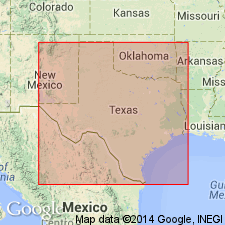
- Usage in publication:
-
- Tesnus formation
- Modifications:
-
- Original reference
- Dominant lithology:
-
- Sandstone
- Shale
- Chert
- Conglomerate
- AAPG geologic province:
-
- Permian basin
Summary:
Pg. 45. Tesnus formation. Consists of sandstone, shale, chert, and a few lenticular layers of conglomerate, with, at base, Rough Creek shale member [new]. Thickness of formation 3,370 feet. Underlies Dimple formation and unconformably overlies Santiago chert (Mississippian?). Age is Pennsylvanian.
Named from exposures at and around Tesnus, Marathon region, Brewster Co., western TX. Named by C.L. Baker.
Source: US geologic names lexicon (USGS Bull. 896, p. 2132-2133).
For more information, please contact Nancy Stamm, Geologic Names Committee Secretary.
Asterisk (*) indicates published by U.S. Geological Survey authors.
"No current usage" (†) implies that a name has been abandoned or has fallen into disuse. Former usage and, if known, replacement name given in parentheses ( ).
Slash (/) indicates name conflicts with nomenclatural guidelines (CSN, 1933; ACSN, 1961, 1970; NACSN, 1983, 2005, 2021). May be explained within brackets ([ ]).

